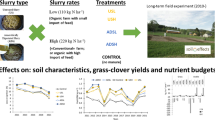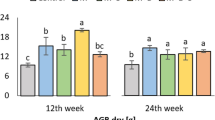Abstract
A 2-year study was carried out to examine the effects of solid cattle manure storage method on (1) total carbon (C) and nitrogen (N) losses, (2) first-year and residual manure dry matter (DM) and N disappearance after litterbag placement on grassland, and (3) apparent herbage N recovery (ANR) after a single surface application to a sandy grassland field. About twelve tonnes of fresh (FRE) manure taken from a litter barn were stored per treatment as stockpiled (STO), composted (COM) and covered (COV) heaps for 130 days, and total C and N losses were estimated. Thereafter, patterns of DM and N disappearance from FRE, COM and COV manures were monitored using litterbags with three mesh sizes (45 μm, 1 mm and 4 mm). Herbage ANR from these manures was measured at application rates of 200, 400 and 600 kg N ha−1. During the storage period, only about 10 % of the initial Ntotal was lost from the COV heap, whereas these losses were 31 % from the STO heap and 46 % from the COM heap. The respective Ctotal losses were 17, 59 and 67 %. After field placement, overall manure DM and N disappearance rates from all mesh sizes of the litterbags were in the order: COV > FRE > COM (P < 0.05). Independent of N application rate, total herbage ANR was the highest from COV and the lowest from COM manure over two growing seasons (23 vs. 14 %; P < 0.05). Including the N losses during storage, an almost three times higher herbage ANR (20 vs. 7 %) of the manure N taken from the barn was observed by using COV versus COM manure. In case of FRE manure this ANR fraction was 17 %. It is concluded that COV storage reduced storage C and N losses to a minimum. After field application, manure stored under this method decomposed faster and more N was available for plant uptake, especially when compared to COM manure.




Similar content being viewed by others
References
Aira M, Sampedro L, Monroy F (2008) Detritivorous earthworms directly modify the structure, thus altering the functioning of a microdecomposer food web. Soil Biol Biochem 40:2511–2516
Anonymous (1998) NEN 7432 Manure and derivatives. Determination of the contents of dry matter and organic matter (in Dutch). Gravimetric method. Dutch Standardization Institute (NNI), Delft, the Netherlands
Berntsen J, Petersen BM, Sörensen P, Olesen JE (2007) Simulating residual effects of animal manures using 15 N isotopes. Plant Soil 290:173–187
Bloem J, Schouten AJ, Sorensen SJ, Rutgers M, van der Werf A, Breure AM (2006) Monitoring and evaluating soil quality. In: Bloem J, Hopkins DW, Benedetti A (eds) Microbiological methods for assessing soil quality. CABI, Wallingford, pp 23–49
Bradford MA, Tordoff GM, Eggers T, Jones TH, Newington JE (2002) Microbiota, fauna, and mesh size interactions in litter decomposition. Oikos 99:317–323
Bremner JM (1965) Organic nitrogen in soil. In: Bartholomew WV, Clark FE (ed) Soil nitrogen. Agronomy Monograph 10, Madison, Wisconsin
Chadwick DR (2005) Emissions of ammonia, nitrous oxide and methane from cattle manure heaps: effect of compaction and covering. Atmos Environ 39:787–799
Cusick PR, Powell JM, Kelling KA, Hensler RF, Muňoz GR (2006) Dairy manure N mineralization estimates from incubations and litterbags. Biol Fert Soils 43:145–152
Dence CW (1992) The determination of lignin. In: Lin SY, Dence CW (eds) Methods in lignin chemistry. Springer, Berlin, pp 33–61
Dewes T (1995) Nitrogen losses from manure heaps. Biol Agric and Hortic 11:309–317
Diaz E, Roldln A, Lax A, Albaladejo J (1994) Formation of stable aggregates in degraded soil by amendment with urban refuse and peat. Geoderma 63:277–288
Didden W, Römbke J (2001) Enchytraeids as indicator organisms for chemical stress in terrestrial ecosystems. Ecotox Environ Safe 50:25–43
Eghball B, Power JF (1999) Phosphorus and nitrogen-based soil and compost application: corn production and soil phosphorus. Soil Sci Soc Amer J 63:895–901
Eghball B, Power JF, Gilley JE, Doran JW (1997) Nutrient, carbon, and mass loss during composting of beef cattle feedlot manure. J Environ Qual 26:189–193
Gutser R, Ebertseder T, Weber A, Schraml M, Schmidhalter U (2005) Short-term and residual availability of nitrogen after long-term application of organic fertilizers on arable land. J Plant Nutr Soil Sci 168:439–446
Hansen MN, Henriksen K, Sommer SG (2006) Observations of production and emission of greenhouse gases and ammonia during storage of solids separated from pig slurry: effects of covering. Atmos Environ 40:4172–4181
Houba VJG, Van Der Lee JJ, Novozamsky I, Walinga I (1989) Soil and plant analysis, a series of syllabi, Part 5. Wageningen University, The Netherlands
Huijsmans JFM, Mosquera J, Hol JMG (2007). Ammonia emission during spreading of solid manure (in Dutch). Deskstudie, Report 155. Plant Research International, Wageningen, The Netherlands
Jenkinson DS, Tinsley J (1959) Studies on the organic material extracted from soil and composts. 1. The isolation and characterisation of ligno-proteins from composts. J Soil Sci 10:245–263
Kirchmann H (1985) Losses, plant uptake and utilization of manure nitrogen during a production cycle. Acta Agri Scand Suppl 24:77
Kirchmann H, Bernal MP (1997) Organic waste treatment and C stabilization efficiency. Soil Biol Biochem 29:1747–1753
Kirchmann H, Witter E (1989) Ammonia volatilization during aerobic and anaerobic manure decomposition. Plant Soil 115:35–41
Larney FJ, Buckley KE, Hao X, McCaughey WP (2006) Fresh, stockpiled, and composted beef cattle feedlot manure: nutrient levels and mass balance estimates in Alberta and Manitoba. J Environ Qual 35:1844–1854
Levi-Minzi R, Riffaldi R, Saviozzi A (1986) Organic matter and nutrients in fresh and mature farmyard manure. Biol Wastes 16:225–236
MAFF (1986) The analysis of agricultural materials. In: MAFF/ADAS reference book 427, 3rd ed. HMSO, London
Misselbrook TH, Nicholson FA, Chambers BJ (2005) Predicting ammonia losses following the application of livestock manure to land. Bioresour Technol 96:159–168
Mkhabela MS, Gordon R, Burton D, Smith E, Madani A (2009) The impact of management practices and meteorological conditions on ammonia and nitrous oxide emissions following application of hog slurry to forage grass in Nova Scotia. Agric Ecosyst Environ 130:41–49
Muñoz GR, Kelling KA, Rylant KE, Zhu J (2008) Field evaluation of nitrogen availability from fresh and composted manure. J Environ Qual 37:944–955
Parkinson R, Gibbs P, Burchett S, Misselbrook T (2004) Effect of turning regime and seasonal weather conditions on nitrogen and phosphorus losses during aerobic composting of cattle manure. Bioresour Technol 91:171–178
Paul JW, Beauchamp EG (1993) Nitrogen availability for corn in soils amended with urea, cattle slurry, and solid and composted manures. Can J Soil Sci 73:253–266
Persson T, Baath E, Clarholm M, Lundkvist H, Soderstrom BE, Sohlenius B (1980) Trophic structure, biomass dynamics and carbon metabolism of soil organisms in a scots pineforest. In: Persson T (ed) Structure and function of northern coniferous forests-an ecosystem study. Ecot Bull Stockholm 32, 419–459
Petersen SO, Lind AM, Sommer SG (1998) Nitrogen and organic matter losses during storage of solid cattle and pig manure. J Agric Sci Camb 130:69–79
Pettygrove GS, Heinrich AL, Eagle AJ (2009) Dairy manure nutrient content and forms. University of California Cooperative Extension. Manure technical bulletin series. http://manuremanagement.ucdavis.edu, visiting date January 2010
Römbke J, Hanagarth W, Höfer H, Garcia M, Martius C (2006) Feeding rates of soil organisms at four different forest sites in Amazonia. J Trop Ecol 22:313–320
Rotz CA (2004) Management to reduce nitrogen losses in animal production. J Animal Sci 82:119-137
Rutgers M, Mulder C, Schouten AJ, Bloem J, Bogte JJ, Breure AM (2008) Soil ecosystem profiling in the Netherlands with ten references for biological soil quality. Report 607604009, RIVM, Bilthoven
Rutgers M, Schouten AJ, Bloem J, van Eekeren N, de Goede RGM, Akkerhuis GAJM, van der Wal A, Mulder C, Brussaard L, Breure AM (2009) Biological measurements in a nationwide soil monitoring network. Eur J Soil Sci 60:820–832
Sagoo E, Williams JR, Chambers BJ, Boyles LO, Matthews R, Chadwick DR (2007) Integrated management practices to minimize losses and maximise the crop nitrogen value of broiler litter. Biosyst Eng 97:512–519
Sana J, Soliva M (1987) Composting. Process, systems and applications (original in Spanish). Servei de Medi Ambient, Diputacio de Barcelona, Barcelona, Spain
Schröder JJ (2005) Manure as a suitable component of precise nitrogen nutrition. In: Proceedings No. 574, International Fertiliser Society, York, UK, pp 1–30
Schröder JJ, Uenk D, Hilhorst GJ (2007) Long-term nitrogen fertilizer replacement value of cattle manures applied to cut grassland. Plant Soil 299:83–99
Shah GM, Rashid MI, Shah GA, Groot JCJ, Oenema O, Lantinga EA (2012a) Mineralization and herbage recovery of animal manure nitrogen after application to various soil types Plant Soil. doi:10.1007/s11104-012-1347-8
Shah GM, Shah GA, Groot JCJ, Oenema O, Lantinga EA (2012b) Irrigation and lava meal use reduce ammonia emission and improve N utilization when solid cattle manure is applied to grassland. Agric Ecosyst Environ 160:59–65
Sharkey MJ (1970) Errors in measuring nitrogen and dry matter content of plant and faeces material. J Br Grassl Soc 25:289–294
Sheldrick WF, Syers JK, Lingard J (2003) Contribution of livestock excreta to nutrient balances. Nutr Cycling Agroecosyst 66:119–131
Sommer SG, Dahl P (1999) Nutrient and carbon balance during the composting of deep litter. J Agr Eng Res 74:145–153
Sommer SG, Hutchings NJ (2001) Ammonia emission from field applied manure and its reduction-invited paper. Eur J Agron 15:1–15
Sonneveld MPW, Lantinga EA (2010) The contribution of mineralization to grassland N462 uptake on peatland soils with anthropogenic A horizons. Plant Soil 340:357–368
Thomsen IK (2001) Recovery of nitrogen from composted and anaerobically stored manure labelled with 15 N. Eur J Agron 15:31–41
Thomsen IK, Olesen JE (2000) C and N mineralization of composted and anaerobically stored ruminant manure in differently textured soils. J Agric Sci 135:151–159
Van Eekeren N, Bommele L, Bloem J, Schouten T, de Goede R, Reheul D, Brussaard L (2008) Soil biological quality after 36 years of ley-arable cropping, permanent grassland and permanent arable cropping. Appl Soil Ecol 40:432–446
Yang HS, Janssen BH (2000) A mono-component model of carbon mineralization with a dynamic rate constant. Eur J Soil Sci 51:517–529
Acknowledgments
This work was financed by the Higher Education Commission of Pakistan. We are equally indebted to Wageningen University for providing technical assistance for this project. We thank Ghulam Abbas Shah, Nicolas Pugeaux, Muhammad Imtiaz Rashid and Crouigneau Pierre for their help in the field work, and Hennie Halm for providing assistance in the laboratory work. Special thanks are due to Johannes Scholberg for critically reading the manuscript. The authors acknowledge the positive comments of two anonymous reviewers which improved the quality of manuscript.
Author information
Authors and Affiliations
Corresponding author
Rights and permissions
About this article
Cite this article
Shah, G.M., Groot, J.C.J., Oenema, O. et al. Covered storage reduces losses and improves crop utilisation of nitrogen from solid cattle manure. Nutr Cycl Agroecosyst 94, 299–312 (2012). https://doi.org/10.1007/s10705-012-9543-8
Received:
Accepted:
Published:
Issue Date:
DOI: https://doi.org/10.1007/s10705-012-9543-8




